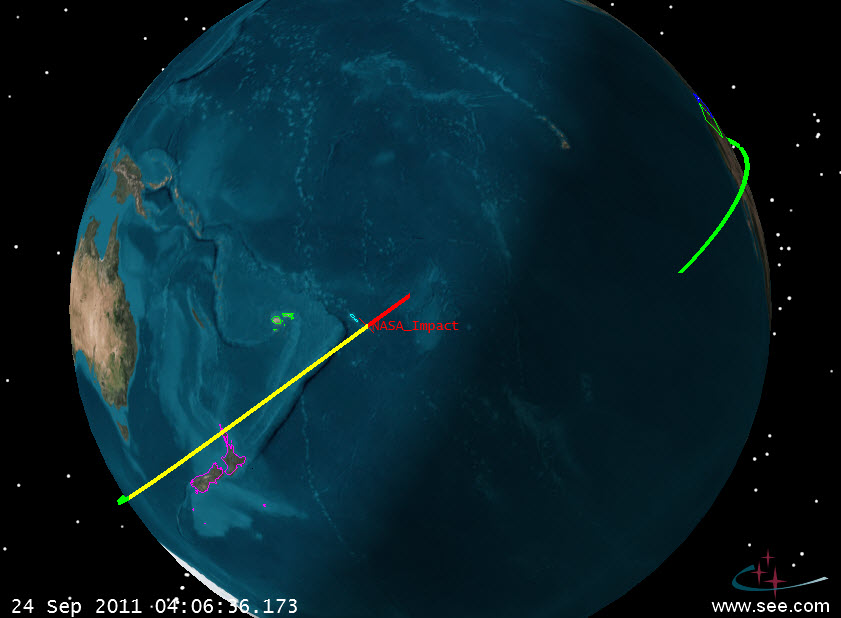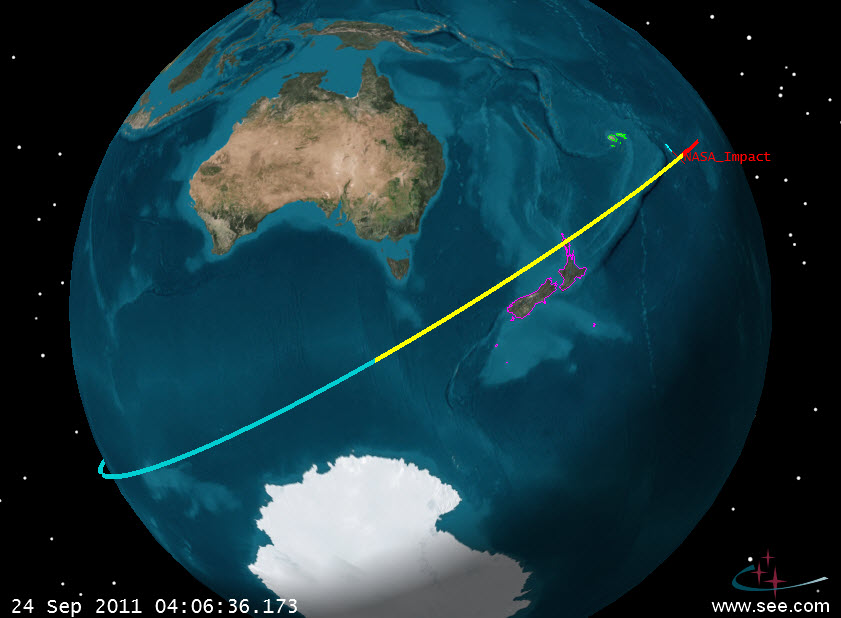After the previous post, I had contacts from several twitter followers with suggestions for improving my predictions. In particular @Marco_Langbroek suggested that 120 km (rather than 80 or 75 km) was the magic number for atmospheric contact, and he further suggested that the 4:16 UTC time originated with the the Joint Space Operations Center (www.space-track.org). It turned out I had an account there already, so I could all but verify that was the source. This makes sense really, because NASA doesn’t have much in the way of assets to track non-cooperative spacecraft. NASA normally tracks spacecraft in the course of communicating with them, and if a spacecraft goes dead, they rely on our military to use radar and other assets for tracking. So any solution you see attributed to NASA in this case very likely came from the JSpOC, and NASA is just the messenger.
Marco also suggested that the time listed by Space-Track was for the 10 km point, rather than higher. We’ll look at that for a few cases here.
The 75-80 km number I have been using is the number usually used for satellite break-up (which I assumed would be when it would start being visible from the ground) but it’s not clear anyone is quoting that time anywhere. The joy of partial information!
NASA has now updated their information (from the TIP Report on Space Track’s page, and no, I don’t know what TIP stands for), indicating that the satellite’s decay time (which means 10 km, according to Marco) was 2011-09-24 4:00 GMT +/- 1 minute. According to NASA this gives a predicted decay location of 14.1 S, 189.8 E. They say the words “decay location” without really telling us what that means.
Let’s compare anyway. I’ve modified my numerical integrator settings a bit to match the reentry settings NASA uses. This mostly means I’ve switched Atmospheric models on portions of my integration. I’m going to leave my “interface” at 80 km for now, because I don’t know any better 🙂
First, here’s where we’d be if the 10 km point (end of the red) was reached at 4:16 UTC.
This gives an impact north-east of Hawaii a bit. The yellow-red transition is at 80 km, red ends at 10 km. The green-yellow boundary (which you can’t see) occurs over New Zealand.
Now let’s look at the 4:00 UTC time, and see where that gets us.
If I leave the entry at 80 km (roughly 50 miles) and target that point to occur at 4:00 UTC, I get the following (Time in lower left is time of 10 km point):
As you can see, the interface occurs very close to the point where NASA (SpaceTrack) says (marked by the cross labeled “NASA Impact” below). This is right near Samoa, but as you can also see it happened over Samoa during the day. That would have made it a lot harder to see.
UARS crosses 120 km at the boundary between the blue and yellow portions below:
If I force the 10 km point to occur at 4:00 UTC we get this:
Anyway, the Space Track information looks credible, I just don’t know exactly what altitude they are specifying for “entry”. If I use 100, instead of 80, I get this:
If I try to force the 120 km interface to occur at 4:00, my 10 km point happens over Africa! So I think the “entry” point is around 80 km. We’ll find out. I’ve got several inquiries into friends at NASA and with the JSpOC to clarify.




